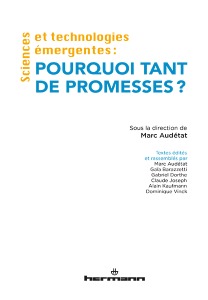Sciences et technologies émergentes, pourquoi tant de promesses? (Emerging Science and Technologies, why so many promises?) is the title of a book (in French only) from a group of authors under the direction of Marc Audétat, a political scientist and researcher at the Sciences -Society Interface of the University of Lausanne. This is not an easy reading book, it is quite demanding, but it raises important questions.
I have already reported on this blog about books that speak of a certain crisis of science, for example in The Crisis and the American model (in French), about the books “La Science à bout de Souffle” or “The University bubble. Should we pursue the American dream?” or in The Trouble With…, a book by Lee Smolin, not to mention the most violent criticism of the promises of technology by Peter Thiel in Technology = Salvation.
This new book explores the promises related to science and technology to the point of talking about an economy of promises. This is a collective work which does not make it an easy reading, but the diversity of points of views is certainly an asset. I have not finished reading it and I will certainly come back to it. In the first chapter, P.-B. Joly describes the system of techno-scientific promises. He begins by introducing the concepts of Imaginary and Vision [Page 33] This “couple of concepts takes into account how various sources of inspiration are involved in the technical creation. […] The Imaginary gives an almost tangible appearance to concepts and ideals that are a priori devoid of it … [and becomes] a common sense that founds the action into society. […] The concept of Vision is close to that of Imaginary, but on a smaller scale. It is akin to that of “rational myth” used to analyze the dynamics of collective action in changing contexts. […] Coalitions of actors form around these visions of a prospective order and contribute to their dynamics. […] If we accept this conceptual distinction between Imaginaries (at large scales – the Nation – and in the long term) and Visions (at a level of coalitions of actors and active over periods of medium length) then comes the question of the interaction between the two.”
“Unlike Visions and Imaginaries, for which the content of technical arrangements is essential, what is essential for the techno-scientific promises is the creation of a relation, as well as a time horizon of expectations. […] Promises are essential in technology creation, because they enable innovators to legitimize their projects, to mobilize resources and to stabilize their environment. […] Any techno-scientific promise must convince a large audience that it determines a better future than the alternatives, even if the realization of the promise requires major, sometimes painful changes.” (The author mentions the history of electricity or the green revolution as the solution to world hunger)
“Our concept of techno-scientific promises has been systematized and became in the last forty years the governance of the new techno-sciences (biotechnology and genomics, nanotechnology, neuroscience, synthetic biology, geo -engineering, etc.) The construction of a techno-scientific promise meets two conflicting constraints: the constraint Radical Novelty and that of Credibility. […] (And I interpret that) for this request to be credible, one must disqualify alternatives. [Furthermore] For a scientific theory to be credible, its validity is neither necessary nor sufficient. […] The techno-scientific promises must have the support of a circle of specialists. Otherwise, they cannot resist the opposition manifested either in scientific arenas, or in public arenas. An extreme version is observed when the specialists refer to natural laws to justify the inevitability of technological change. (Examples are Moore’s Law and Gabor’s Law.) Thus, in principle, generic promises are not subject to validity tests.”
Finally, this intensification is reinforced by three complementary elements [page 39]:
– the future is more a threat than a source of hope;
– research and innovation are often presented as the only way to solve problems;
– the research stakeholders should demonstrate their societal impacts.
This leads to pathologies [pages 40-43]:
– the myth of a public victim of irrational fears and to be educated becomes an intangible scheme;
– the promises turn into bubbles;
– the radical novelty and uncertainty create conflicting discourses, sources of mistrust because the effects of such radicalism is not predictable so that through experimentation, the technologists become sorcerer’s apprentices and society, a laboratory;
– finally promises lead to endless discussions on fictions, on issues that may have nothing to do with the reality of research.
In conclusion Joly thinks this promises system is one of the enemies of the future because of the clear separation it creates between those who make the promise and those who are supposed to accept it. The recognition of this regime and therefore these problems is a prerequisite imperative.
After reading the first chapter, I remembered the societal concerns of Cynthia Fleury, about whom I have already said a few things in a digression in the article On France Culture, Transhumanism is Science Fiction. Our democratic societies are in crisis, and the distrust of politics as well as of experts has never been stronger. The issue of research and innovation is a component of this crisis. I am eager to discover the rest of this very interesting (and important) work …

